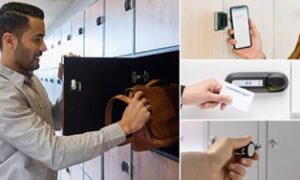
Often overlooked, storage for valuables, documents and personal items deserves the same protection as offices, labs or accommodation. Yet many access solutions leave these important access points poorly secured. Intelligent electronic control often stops at the door, ignoring the critical safety needs of many forgotten openings.
One common facilities management solution is to run two systems in parallel: electronic access for doors, and mechanical security for “non-door” openings which many electronic systems cannot accommodate. However, according to Assa Abloy, running two access control workflows based on different technologies increases risk and complexity, and eats up admin time. Users carry multiple credentials, so there is more chance they lose one. Security teams now must issue, track and monitor multiple credentials and credential types. It creates unnecessary hassle for everyone.
A cabinet or drawer lock fitted at relevant points, and integrated with the central system, can give many valuable assets the security they require. Once integrated with the system software, this electronic device can deter unauthorised access and reduce workplace theft − which according to research in the USA alone may cost businesses $50 billion each year.
In the healthcare sector, enhanced cabinet security can protect medicines and confidential documents. In universities and schools, students and staff can experience peace of mind when they can leave belongings in lockers in communal areas or changing rooms which are properly secured.
In today’s more flexible workplaces, many office users don’t have “their” desk, where confidential or valuable assets are stored safely. They just use “a” desk. Unsurprisingly, according to research from business services provider Clutch, almost a quarter of coworking space users have security concerns. The right cabinet security does more than just save management time. It also helps building users become relaxed about their belongings’ safety.
Assa Abloy offers a choice of security solutions for these forgotten access points. In many cases, multiple non-door locking types may also be integrated with a third-party system and managed together, to maximise the flexibility and efficiency of security admin.
The new battery-powered Aperio KL100, for example, secures lockers, cabinets, cupboards, drawers and more. It makes almost any small opening an integral part of an electronic access control system. Designed for minimal disruption to furniture, its tiny footprint and wire-free operation ensure quick installation without causing damage or making a visual impact. It integrates seamlessly with any new or existing access control system — from over 100 different manufacturers and counting.
For example, Finavia, operator of Helsinki Airport, must lock all types of openings, from doors and cabinets to fences and cargo. Devices all integrate seamlessly with their Lenel access control system. Check-in desks are fitted with Aperio KL100 locking, to ensure travel documents are stored safely. Audit trail capability simplifies the process of learning who accessed the storage and when.
This is much easier to monitor than mechanical key security: “When employees change, their access is disabled,” explains Kari Mäkinen, the airport’s Senior Access Control Specialist. “Or if the card is lost, it can be completely removed from the system. With mechanical keys, that process is much harder.”
A further example is at the Funway Academic Resort, student accommodation in Madrid, where a single Smartair system provides flexible, reliable electronic protection for bedrooms, common areas and student safes. No sensitive openings are overlooked. Part of the Smartair complete access control solution, Smartair e-motion Cabinet Locks with integrated RFID readers work with a wide range of credentials. They offer convenient unlocking via smartphone and are easily managed together with wireless door locking devices and electronic padlocks using Smartair’s intuitive software.











